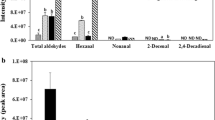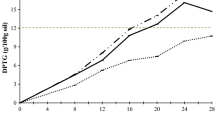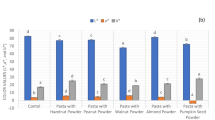Abstract
The health benefits of phenolic antioxidants justify their inclusion in foods like deep-fried potato fritters that are exposed to high heat during processing. In this study, phenolic antioxidants [quercetin, rutin or an apple phenolic extract (APE)] were incorporated into batters that were subsequently used in the preparation of deep-fried potato fritters. The fritters were deep fried at 180 °C for 2.5 min or 165 °C for 3 min using fresh or used canola oil. The study aimed to investigate the effect of added phenolic antioxidants on the lipid deterioration during deep frying potato fritters. The effectiveness of these phenolics against lipid deterioration was also examined for the potato fritters that have been left in the air at room temperature for 0.5 or 1 h after deep frying. The total oxidation (Totox) value (based on the peroxide value and p-anisidine value) and free fatty acid content of the oil extracted from the deep-fried potato fritters, as well as the total extractable phenolic content, of the fritters were evaluated. Results showed that APE, quercetin and rutin suppressed oil deterioration to different extents, and their effectiveness was influenced by deep-frying conditions, the number of times the oil had been used and the time period that the fritter was exposed to the air after deep frying. For the fresh or singly used oil, the recommended deep-frying parameters are 180 °C for 2.5 min (“high heat short time” approach). For oil used more than once, deep frying of potato fritters at 165 °C for 3 min (“low heat long time” approach) is generally recommended. Adding phenolics to the batter used for making potato fritters before deep frying increases product nutritional value and reduces oil oxidation, which indicates the feasibility of producing healthier potato fritters.



Similar content being viewed by others
References
Ackman, R. G. (1990). Canola and rapeseed. Production, chemistry, nutrition and processing technology (p. 81). New York: Avi Book.
Allam, S. S. M., & El-Sayed, F. E. (2004). Fortification of fried potato chips with antioxidant vitamins to enhance their nutritional value and storage ability. Grasas Y Aceites, 55(4), 434–443.
Anwar, F., Qayyum, H. M. A., Hussain, A. I., & Iqbal, S. (2010). Antioxidant activity of 100 % and 80 % methanol extracts from barley seeds (Hordeum vulgare L.): stabilization of sunflower oil. Grasas Y Aceites, 61(3), 237–243.
AOCS. (1998a). Peroxide value acetic acid-chloroform method Cd 8–53. In D. Firestone (Ed.), Official methods and recommended practices of the American Oil Chemists’ Society. AOCS: Champaign.
AOCS. (1998b). P-anisidine value method Cd 18–90. In D. Firestone (Ed.), Official methods and recommended practices of the American Oil Chemists’ Society. AOCS: Champaign.
AOCS. (2000). Free fatty acids in crude and refined oils method 26.042. In D. Firestone (Ed.), Official methods and recommended practices of the American Oil Chemists’ Society. AOCS: Champaign.
Arts, I. C. W., & Hollman, P. C. H. (2005). Polyphenols and disease risk in epidemiologic studies. American Journal of Clinical Nutrition, 81(1), 317S–325S.
Astrup, A., Dyerberg, J., Elwood, P., Hermansen, K., Hu, F. B., Jakobsen, M. U., Kok, F. J., Krauss, R. M., Lecerf, J. M., LeGrand, P., Nestel, P., Risérus, U., Sanders, T., Sinclair, A., Stender, S., Tholstrup, T., & Willett, W. C. (2011). The role of reducing intakes of saturated fat in the prevention of cardiovascular disease: where does the evidence stand in 2010. American Journal of Clinical Nutrition, 93, 684–688.
Bognar, A. (1998). Comparative study of frying to other cooking techniques influence on the nutritive value. Grasas y Aceites, 49(3, 4), 250–260.
Boudet, A. M. (2007). Evolution and current status of research in phenolic compounds. Phytochemistry, 68, 2722–2735.
Bravo, L. (1998). Polyphenols: chemistry, dietary sources, metabolism and nutritional significance. Nutrition Reviews, 56, 317–333.
Chang, Y. C., Almy, E. A., Blamer, G. A., Gray, J. I., Frost, J. W., & Strasburg, G. M. (2003). Antioxidant activity of 3-dehyroshikimic acid in liposomes, emulsions and bulk oil. Journal of Agriculture and Food Chemistry, 51, 2753–2757.
Cheung, S., Szeto, Y., & Benzie, I. (2007). Antioxidant protection of edible oils. Plant Foods for Human Nutrition (Formerly Qualitas Plantarum), 62, 39–42.
Choe, E. (2007). Effects and mechanism of minor compounds in oil on lipid oxidation. In C. C. Akoh & D. B. Min (Eds.), Food lipids: chemistry, nutrition and biotechnology (pp. 49–67). New York: Taylor and Francis Group, CRC Press.
Choe, E., & Min, D. B. (2006). Mechanisms and factors for edible oil oxidation. Comprehensive Reviews in Food Science and Food Safety, 5, 169–186.
Choe, E., & Min, D. B. (2007). Chemistry of deep-fat frying oils. Journal of Food Science, 72(5), R77–R86.
Chung, J., Lee, J., & Choe, E. (2004). Oxidative stability of soybean and sesame oil mixture during frying of flour dough. Journal of Food Science, 69, 574–578.
Coppen, P. P. (1989). The use of antioxidants. In J. C. Allen & R. J. Hamilton (Eds.), Rancidity in foods (2nd ed., pp. 83–104). London: Elsevier.
Drewnowski, A., & Almiron-Roig, E. (2010). Human perception and preferences for fat-rich foods. In J. P. Montmayeur & J. le Coutre (Eds.), Fat detection: taste, texture, and post ingestive effects. Boca Raton: CRC Press.
Fillion, L., & Henry, C. J. (1998). Nutrient losses and gains during frying: a review. International Journal of Food Sciences and Nutrition, 49, 157–168.
Frankel, E. N. (1996). Antioxidants in lipid foods and their impact on food quality. Food Chemistry, 57, 51–55.
Frankel, E. N. (1998). Lipid oxidation. Dundee: Oily Press.
Frankel, E. N. (2005). Lipid oxidation (2nd ed.). Bridgewater: The Oily Press. PJ Barnes & Associates. University of California, Davis, California, USA.
Frankel, E. N., Satué-Gracia, R., Meyer, A. S., & German, J. B. (2002). Oxidative stability of fish and algae oils containing long-chain polyunsaturated fatty acids in bulk and in oil-in-water emulsions. Journal of Agricultural and Food Chemistry, 50, 2094–2099.
Frega, N., Mozzon, M., & Lecker, G. (1999). Effects of free fatty acids on oxidative stability of vegetable oil. Journal of the American Oil Chemists’ Society, 76, 325–329.
Ghidurus, M., Turtoi, M., Boskou, G., Niculita, P., & Stan, V. (2010). Nutritional and health aspects related to frying (I). Romanian Biotechnological Letters, 15(6), 5675–5682.
Gordon, M. H. (1990). The mechanisms of antioxidant action in vitro. In B. J. F. Hudson (Ed.), Food Antioxidants (pp. 1–18). London: Elsevier Applied Science.
Guallar-Castillón, P., Rodriguez-Artalejo, F., Fornes, N. S., Banegas, J. R., Etxezarreta, P. A., Ardanaz, E., Barricarte, A., Chirlaque, M. D., Iraeta, M. D., Larrañaga, N. L., Losada, A., Mendez, M., Martínez, C., Quirós, J. R., Navarro, C., Jakszyn, P., Sánchez, M. J., Tormo, M. J., & González, C. A. (2007). Intake of fried foods is associated with obesity in the cohort of Spanish adults from the European prospective investigation into cancer and nutrition. American Journal of Clinical Nutrition, 86, 198–205.
Iqbal, R., Anand, S., Ounpuu, S., Islam, S., Zhang, X., Rangarajan, S., Chifamba, J., Al-Hinai, A., Keltai, M., & Yusuf, S. (2008). Dietary patterns and the risk of acute myocardial infarction in 52 countries: results of the interheart study. Circulation, 118, 1929–1937.
Irwin, J. W., & Hedges, N. (2004). Measuring lipid oxidation. In R. Steele (Ed.), Understanding and measuring the shelf-life of food. Cambridge: Woodhead Publishing Ltd, CRC Press.
Jayarajah, A. & Sevugan, A. (2009). Key trends in healthy convenience foods. Asia Pacific Food Industry, March, 72–74
Kristott, J. (2000). Fats and oils. In D. Kilcast & P. Subramaniam (Eds.), The stability and shelf-life of food. Boca Raton: Woodhead Ltd.
Mazza, G., & Qi, H. (1992). Effect of after-cooking darkening inhibitors on stability of frying oil and quality of French fries. Journal of the American Oil Chemist Society, 69, 847–853.
Moreira, R. G., Elena Castell-Perez, M., & Barrufet, M. A. (1999). Deep-fat frying: fundamental and applications. Maryland: Aspen Publication.
Moreiras-Varela, O., Ruiz-Roso, B., & Varela, G. (1988). Effects of frying on the nutritional value of foods. In G. Valera, A. E. Bender, & I. D. Morton (Eds.), Frying of food: principles, changes, new approaches (pp. 93–102). Chichester: Ellis Horwood Ltd.
Murkovic, M. (2003). Phenolic compounds. In B. Caballero, L. C. Trugo, & P. Finglas (Eds.), Encyclopedia of food sciences and nutrition (Vol. 7, pp. 4507–4514). New York: Academic.
Nawar, W. W. (1996). Food chemistry. In O. R. Fennema (Ed.), Lipids. New York: Marcel Dekker.
Ng, T. K. W. (2007). Local repeatedly-used deep frying oils are generally safe. International E-Journal of Science, Medicine and Education, 1(2), 55–60.
O’Brien, R. (1993). Foodservice use of fat and oils. Inform, 4(8), 913–921.
O’Connor, C. J., Fisk, K. J., Smith, B. G., & Melton, L. D. (2001). Fat absorption in French fries as affected by different potato varieties and processing. Journal of Food Science, 66, 903–908.
O’Connor, C. J., Lal, S. N. D., & Eyres, L. (Eds.). (2007). Handbook of Australasian edible oils. Auckland: Oils and Fats Specialist Group of NZIC.
Olias, J. M., Perez, A. G., Rios, J. J., & SAN, L. C. (1993). Aroma of virgin olive oil: biogenesis of the “green” odor notes. Journal of Agriculture and Food Chemistry, 3993, 2368–2373.
Omololu, P. A., Rocha, J. B. T., & Kade, I. J. (2011). Attachment of rhamnosyl glucoside on quercetin confers potent iron-chelating ability on its antioxidant properties. Experimental and Toxicologic Pathology, 63, 249–255.
Pazos, M., Andersen, M. L., Medina, I., & Skibsted, L. H. (2007). Efficiency of natural phenolic compounds regenerating R-tocopherol from R-tocopheroxyl radical. Journal of Agriculture and Food Chemistry, 55, 3661–3666.
Pedreschi, F. (2009). Fried and dehydrated potato products. In J. Singh & L. Kaur (Eds.), Advances in potato chemistry and technology (pp. 319–337). Burlington: Academic.
Perez-Granados, A. M., Vaquero, M. P., & Navarro, M. P. (2000a). Intake of unused palm olein and palm olein used in frying does not affect calcium and phosphorus bioavailability in rats. Journal of the Science of Food and Agriculture, 80, 1379–1385.
Perez-Granados, A. M., Vaquero, M. P., & Navarro, M. P. (2000b). Sunflower oil versus olive oil and iron metabolism in rats. Influence of a frying process. Journal of the Science of Food and Agriculture, 81, 115–120.
Pino, E., Campos, A. M., Lopez-Alarcon, C., Aspee, A., & Lissi, E. (2006). Free radical scavenging capacity of hydroxycinnamic acids and related compounds. Journal of Physical Organic Chemistry, 19, 759–764.
Pokorn, J., Panek, J., & Trojakova, L. (2003). Effect of food component changes during frying on the nutrition value of fried food. Forum of Nutrition, 56, 348–350.
Pokorny, J. (1999). Changes in nutrients at frying temperatures. In D. Boskou & I. Elmadfa (Eds.), Frying of food (pp. 69–103). Boca Raton: CRC Press.
Rice-Evans, C. A., Miller, N. J., & Paganga, G. (1996). Structure antioxidant activity relationships of flavonoids and phenolic acids. Free Radical Biology & Medicine, 20, 933–956.
Romero, A., Cuesta, C., & Sanchez-Muniz, F. J. (1998). Effect of oil replenishment during deep-fat frying of frozen foods in sunflower oil and high-oleic acid sunflower oil. Journal of the American Oil Chemists’ Society, 75, 161–167.
Samra, R. A. (2010). Fat detection: taste, texture, and post ingestive effects. In J. P. Montmayeur & J. le Coutre (Eds.), Fats and satiety. Boca Raton: CRC Press.
Sanchez-Muniz, F. J., Cuesta, C., & Garrido-Polonio, M. C. (1994). Evaluation of a sunflower oil used for frying by different analytical indexes and column and gas chromatography. Zeitschrift für Ernährungswissenschaft, 33, 16–23.
Sayon-Orea, C., Bes-Rastrollo, M., Basterra-Gortari, F. J., Beunza, J. J., Guallar-Castillon, P., de la Fuente-Arrillaga, C., & Martinez-Gonzalez, M. A. (2011). Consumption of fried foods and weight gain in a Mediterranean cohort: the SUN project. Nutrition, Metabolism, and Cardiovascular Diseases. doi:10.1016/j.numecd.2011.03.014.
Schlosser, E. (2001). Fast food nation: the dark side of all American meal (pp. 1–10). Boston: Houghton Mifflin.
Singleton, V. L., Orthofer, R., Lamuela-Raventos, R. M., & Lester, P. (1997). Analysis of total phenols and other oxidation substrates and antioxidants by means of Folin Ciocalteu reagent. Methods in Enzymology, 229A, 152–178.
Soorgi, M., Mohebbi, M., Mousavi, S. M., & Shahidi, F. (2011). The effect of methylcellulose, temperature, and microwave pretreatment on kinetic of mass transfer during deep fat frying of chicken nuggets. Food and Bioprocess Technology. doi:10.1007/s11947-011-0520-z.
Sørensen, A. D., Haahr, A. M., Becker, E. M., Skibsted, L. H., Bergenståhl, B., Nilsson, L., & Jacobsen, C. (2008). Interactions between iron, phenolic compounds, emulsifiers, and pH in omega-3-enriched oil-in-water emulsions. Journal of Agricultural and Food Chemistry, 56, 1740–1750.
Soriguer, F., Rojo-Martinez, G., Dobarganes, M. C., Garcia Almeida, J. M., Esteva, I., Beltran, M., Ruiz De Adana, M. S., Tinahones, F., Gómez-Zumaquero, J. M., García-Fuentes, E., & González-Romero, S. (2003). Hypertension is related to the degradation of dietary frying oils. American Journal of Clinical Nutrition, 78, 1092–1097.
Stevenson, S. G., Vaisey-Genser, M., & Eskin, N. A. M. (1984). Quality control in the use of deep frying oils. Journal of the American Oil Chemists’ Society, 61, 1102–1108.
Stevenson, D. E., Wibisono, R., Jensen, D. J., Stanley, R. A., & Cooney, J. M. (2006). Direct acylation of flavonoid glycosides with phenolic acids catalysed by Candida antarctica lipase B (Novozym 435(R)). Enzyme and Microbial Technology, 39, 1236–1241.
Sun-Waterhouse, D., Penin-Peyta, L., Wadhwa, S. S., & Waterhouse, G. I. N. (2011). Storage stability of phenolic-fortified avocado oil encapsulated using different polymer formulations and co-extrusion technology. Food and Bioprocess Technology. doi:10.1007/s11947-011-0591-x.
Sun-Waterhouse, D., Zhou, J., Miskelly, G. M., Wibisono, R., & Wadhwa, S. S. (2011). Stability of encapsulated olive oil in the presence of caffeic acid. Food Chemistry, 126(3), 1049–1056.
Sun-Waterhouse, D., Thakorlal, J., & Zhou, J. (2011). Effects of added phenolics on the storage stability of avocado and coconut oils. International Journal of Food Science and Technology, 46(8), 1575–1585.
Torres, A. M., Mau-Lastovicka, T., & Rezaaiyan, R. (1987). Total phenolics and high-performance liquid chromatography of phenolic acids of avocado. Journal of Agricultural and Food Chemistry, 35, 921–925.
Tsaknis, J., Spiliotis, V. S., Lalas, S., Gergis, V., & Dourtoglou, V. (1999). Quality changes of Moringa oleifera, variety mbololo of Kenya seed oil during frying. Grasas y Aceites, 50, 37–48.
Tsuzuki, W., Nagata, R., Yunoki, R., Nakajima, M., & Nagata, T. (2008). Cis/trans-isomerisation of triolein, trilinolein and trilinolenin induced by heat treatment. Food Chemistry, 108, 75–80.
Wanasundara, P. K. J. P. D., & Shahidi, F. (2005). Antioxidants: science, technology, and applications. In F. Shahidi (Ed.), Bailey’s industrial oil and fat products (pp. 431–489). USA: John Wiley & Sons.
Warner, K., & Mounts, T. L. (1993). Frying stability of soybean and canola oils with modified fatty acid compositions. Journal of the American Oil Chemists’ Society, 70(10), 983–988.
Xu, X.-Q., Tran, V. H., Palmer, M., White, K., & Salisbury, P. (1999). Chemical and physical analyses and sensory evaluation of six deep-frying oils. Journal of the American Oil Chemists’ Society, 76, 1091–1099.
Zhang, W. H., Shi, B., & Jeff, S. (2007). A theoretical study on autoxidation of unsaturated fatty acids and antioxidant activity of phenolic compounds. Journal of the American Leather Chemists Association, 102(3), 99–105.
Acknowledgments
The authors acknowledge technical assistance from Mr. David Jin (Plant & Food Research) at the beginning of this project and reviews from Dr. Geoffrey I.N. Waterhouse (The University of Auckland). Miss Dongni Xue from The University of Auckland thanks the internship placement at Plant & Food Research, Mt. Albert, in the summer of 2011–2012.
Author information
Authors and Affiliations
Corresponding author
Rights and permissions
About this article
Cite this article
Sun-Waterhouse, D., Xue, D. & Wadhwa, S. Effects of Added Phenolics on the Lipid Deterioration and Antioxidant Content of Deep-Fried Potato Fritters. Food Bioprocess Technol 6, 3256–3265 (2013). https://doi.org/10.1007/s11947-012-1001-8
Received:
Accepted:
Published:
Issue Date:
DOI: https://doi.org/10.1007/s11947-012-1001-8




